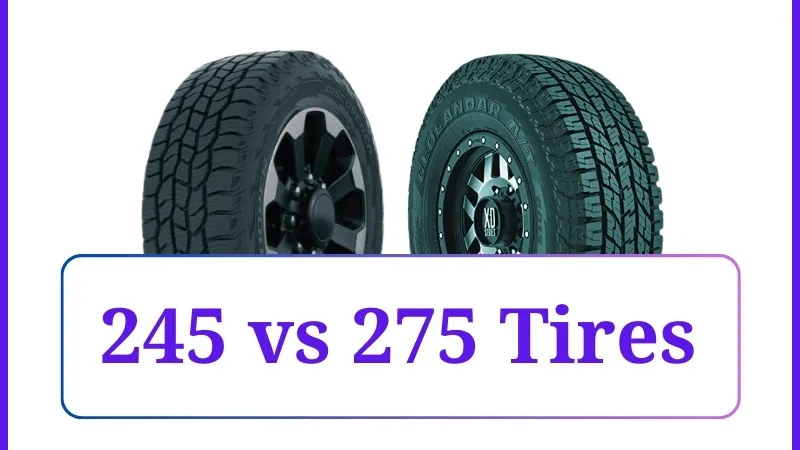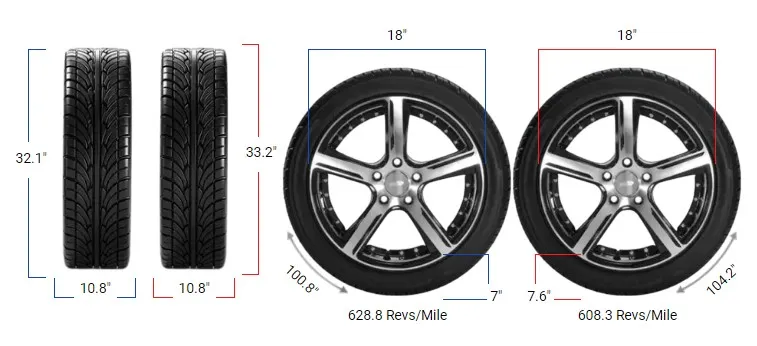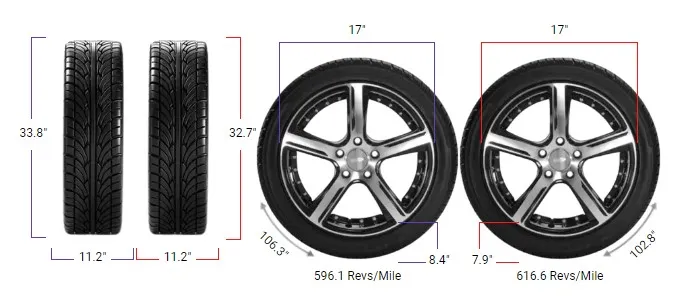245 vs 275 Tires

The primary difference between 245 and 275 tires lies in their width. The 275 tires is about 30 mm wider than the 245 tires. A 245 tire has a width of 245 millimeters, whereas a 275 tire measures 275 millimeters wide.
This difference can significantly impact your vehicle’s performance, affecting traction, fuel efficiency, and handling.
The 275 tire features a wider contact patch, which generally results in improved grip and stability, particularly during cornering or high-speed driving.
This extra width can make 275 tires an appealing choice for drivers who value enhanced performance and a sportier feel.
On the other hand, 245 tires offer a balance of traction and efficiency, making them more suitable for daily use, where fuel economy and comfort are top priorities.

Fitment Guide
Before deciding whether to switch between 245 and 275 tires, it’s essential to understand the fitment requirements. Below is the Ideal Rim Width Range for each tire size:
- 245 tire: Compatible with rims that are 7.5 to 9.0 inches wide.
- 275 tire: Suitable for rims ranging from 9.0 to 10.5 inches wide.
In this case, 245 and 275 tires are compatible with rims 9.0 inches wide, making a swap possible without needing to change the rims.
Although, the aspect ratio and rim diameter must remain consistent, or the difference in overall diameter should be within 3% to maintain speedometer accuracy and proper vehicle handling.
If these conditions are not met, swapping tire sizes may negatively impact performance and safety.

On-Road Performance
The 275 tire provides improved handling and stability due to its wider contact patch, allowing for greater grip on the road. This makes 275 tires an excellent choice for drivers seeking enhanced performance, particularly during high-speed maneuvers and sharp cornering.
The additional width translates to increased traction, which is especially beneficial when driving in wet or challenging conditions.
In contrast, 245 tires offer a more balanced approach, with lighter steering and improved maneuverability, making them ideal for urban driving.
The narrower profile helps reduce rolling resistance, resulting in a more responsive and agile driving experience. For those who prioritize ease of handling and daily driving comfort, 245 tires may be the better option.
Fuel Efficiency: One of the notable advantages of 245 tires is their superior fuel efficiency. The narrower width reduces rolling resistance, which means the vehicle requires less energy to maintain speed. This makes 245 tires an excellent choice for those who drive long distances or want to maximize fuel economy.

On the other hand, 275 tires provide better grip and stability, but the increased rolling resistance can lead to decreased fuel efficiency. This trade-off is worth considering if your priority is performance rather than saving on fuel costs.
Ride Comfort: In terms of ride comfort, 245 tires generally offer a smoother and quieter ride, particularly on well-maintained roads. The narrower width helps minimize road noise and makes for a more comfortable experience, especially during long highway drives or daily commutes.
275 tires can provide a firmer ride due to their larger contact area and increased sidewall stiffness. While they offer improved stability, the ride may feel bumpier on rough or uneven roads, which may not be ideal for those seeking maximum comfort. However, for drivers who prefer a sportier driving experience with enhanced control, 275 tires can be an attractive option.
Off-Road Performance
For off-road enthusiasts, 275 tires are generally better suited for rough terrains. The wider footprint provides more traction on loose surfaces, such as gravel, mud, or sand, improving stability and reducing the risk of getting stuck.
This makes 275 tires a popular choice for trucks and SUVs that frequently venture off the beaten path. 245 tires, while capable of handling light off-road conditions, do not provide the same level of traction as 275 tires on challenging surfaces.

Their narrower profile can limit grip on loose or uneven terrain. However, for occasional off-road use, 245 tires offer sufficient versatility, making them a practical option for drivers who primarily drive on-road but occasionally need to venture off-road.
Speedometer Impact
Switching between 245 and 275 tires can impact your vehicle’s speedometer and odometer accuracy. A change in overall diameter may cause discrepancies in speed and distance readings. For example, if the 275 tire has a larger overall diameter than the 245 tire, the speedometer might display a speed lower than the actual speed.
To maintain accurate speed and distance measurements, it may be necessary to recalibrate the speedometer if the difference in overall diameter exceeds 3%. Proper calibration is essential for maintaining accurate performance metrics and ensuring compliance with speed limits.
Benefits of 275 Tires:
- Enhanced Traction and Stability: The wider contact area provides improved grip, especially in high-speed and off-road conditions.
- Aggressive Appearance: 275 tires give vehicles a more rugged and sporty look, which can be appealing for those seeking a more commanding presence.
- Improved Off-Road Capability: The larger footprint offers better flotation on loose surfaces, making 275 tires ideal for off-road driving.
Drawbacks of 275 Tires:
- Lower Fuel Efficiency: The increased rolling resistance of 275 tires can lead to reduced fuel efficiency, particularly in city driving.
- Increased Road Noise: The wider profile may contribute to more road noise, which can be noticeable at higher speeds.

Benefits of 245 Tires:
- Better Fuel Economy: The narrower width reduces rolling resistance, leading to improved fuel efficiency, making 245 tires ideal for long commutes.
- Easier Maneuverability: The lighter steering effort makes 245 tires easier to handle, particularly in urban environments.
- Quieter Ride: The reduced contact patch helps minimize road noise, contributing to a more comfortable and quieter driving experience.
Drawbacks of 245 Tires:
- Limited Traction: Compared to 275 tires, 245 tires have a smaller contact area, which can reduce traction, especially in wet or challenging conditions.
- Less Aggressive Appearance: 245 tires may not provide the same bold aesthetic as wider 275 tires, which can be important for those seeking a sportier look.
Difference Between 245 and 275 Tires
The main difference between 245 and 275 tires is their width. 275 tires are 30mm wider than 245 tires, which affects handling, stability, and overall vehicle performance.

Can I Use 245 Tires Instead of 275?
Yes, you can use 245 tires instead of 275 tires because their ideal rim width ranges overlap. However, narrower tires may impact stability and handling, so consider these trade-offs.
Ensure the aspect ratio and rim diameter are the same, or that the overall diameter difference is within 3% to maintain safety and accuracy.
Can I Use 275 Tires Instead of 245?
Yes, you can use 275 tires instead of 245 tires since their ideal rim width ranges overlap, ensuring compatibility. However, wider tires may impact ride comfort and fuel efficiency.
Also, ensure that the aspect ratio and rim diameter match your current tires, or that the overall diameter difference is within 3% to avoid affecting speedometer accuracy and vehicle handling.
Can You Put 245 Tires on 275 Rims?
Yes, you can put 245 tires on rims designed for 275 tires. The ideal rim width range for both sizes overlaps, allowing for proper fitment. However, using narrower tires may affect handling and stability.

Can You Put 275 Tires on 245 Rims?
Yes, it is possible to put 275 tires on rims designed for 245 tires, as their ideal rim width ranges overlap. However, using wider tires may impact ride comfort and handling, so it’s important to consider these factors.
Our Observation
The decision between 245 and 275 tires largely depends on your driving preferences and needs. If you prioritize fuel efficiency, maneuverability, and a comfortable ride, 245 tires are likely the better choice.
On the other hand, if you seek maximum traction, stability, and a more aggressive look, 275 tires are worth considering.
It is important to ensure that the rims are compatible and that the overall diameter change is within acceptable limits to maintain safety and performance.



